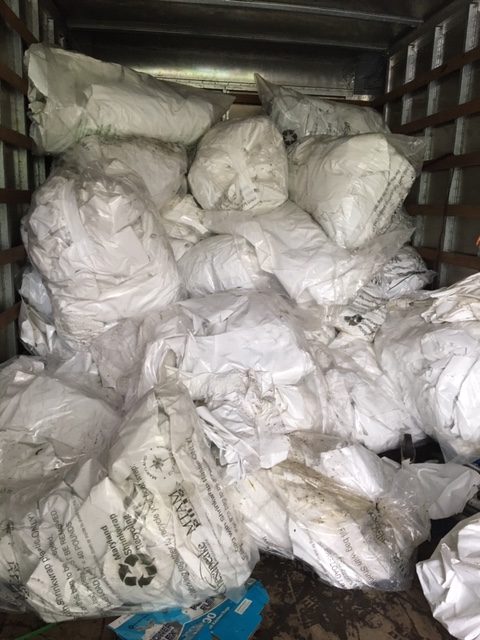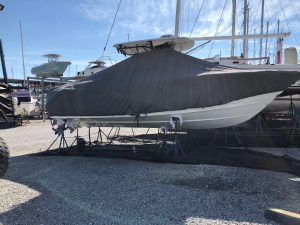
Finding Second Life Solutions for Used Shrink Wrap
Published on April 29, 2021With launch season in full swing, many marinas and boat owners are ripping off the shrink wrap that cocooned their boats through the cold, rainy, and snowy winter. The low-density, polyethylene film serves as an ideal protective barrier between boat and elements. But as environmental awareness spreads more and more each year, the industry is starting to question whether this landfill clogging material is the best answer.
Marine trades and clean marina programs have grappled with this issue for years right alongside the marinas. The best solution to date has been recycling programs, but questions arise if this is a long-term solution.
Maryland Looks Toward Alternatives
A long-standing effort at recycling has come from a joint effort of the Maryland Clean Marina Program and the Marine Trades Association of Maryland (MTAM). For nearly 20 years they have been working through how to recycle shrink wrap and in the past two years began selling and distributing bags for marinas to place their used shrink wrap and then working with Chesapeake Materials to collect and ship off the material for recycling.
Each $15 bag holds up to 40 pounds of clean shrink wrap with the cost encompassing pickup and transport of the bags as well as recycling. The size and pound limit of the bag means it can accommodate wrap from up to a 35-foot boat. Preparation of the shrink wrap before it is bagged is critical to the program. All straps, zippers, doors, and vents must be removed or recyclers will not accept the material. The program also offers decals that can be placed on the bags with instructions on how to remove and prepare the wrap. Marinas are encouraged to sell the bags directly to their boating customers or even to contractors.

While the recycling program is certainly a better alternative to placing the plastic in the trash, Donna Morrow, director of the state’s clean marina program, says they are hardly making a dent in the problem. They have 24 marinas committed to the program and with a 30,000 lb goal, they’ll capture enough to fill a shipping container. As Morrow says the idea that the waste is shipped over seas is disappointing. There just aren’t enough domestic recyclers and those that are working with the boating industry need 40,000 lbs bailed and ready to go so they can pick it up in a truck. She says that’s a tough goal for a state to meet.
Finding the marinas to get involved is also challenging. While removing, prepping, and stuffing the wrap into a bag takes an average of just 10 minutes, for a yard with 300 or more boats, that’s a large chunk of manpower that in launch season they often can’t spare. Marinas can sell the bags to customers, but often customers do not understand how to properly prepare the material for recycling, they are absentee, or they just don’t want an additional cost.
Morrow is involved with the federal marine debris program for the Mid-Atlantic and says she is now looking at the shrink wrap problem through a broader lens. “If you’re going to put it out there then what’s your responsibility to take it back? Literally shrink wrap is a mountain of waste and the industry is stuck with the problem of how to attack it,” she said.

With this in mind, she has been working with the BoatUS Foundation on an alternative “Think Before You Shrink” campaign, although she says it’s a campaign with no money behind it. The idea is to encourage boaters to use semi-custom covers that last more than one season. Such covers are sold through marine stores and are typically a sunproof cloth outside with a laminate inside to prevent moisture build up. They cost more than shrink wrap, about the same as two seasons of shrink wrap, and they do need to be stored for the season although Morrow says they roll up much smaller than she thought they would. They last from five to 10 years but are limited to boats under 30-feet.
Morrow conducted a survey of marinas and boatyards to determine their thoughts on reusable covers. She said she was surprised that 13% were already selling reusable covers and of those that were not, 20% had simply never thought to do it. Barriers were whether customers would buy the covers although a majority felt their boaters really cared about the environment.
The survey indicated that facilities could offer installation and removal service along with the sale of the covers, and even charge for storage. Of those surveyed, 22% said they would not be able to offer any of those services. However, 28% said they’d be willing to try reusable covers, although they pointed out that they would not work for all their boats with sailboats, and larger vessels not conducive to the semi-custom covers typically sold.
In surveying boaters, 35% were already using a fitted cover, 37% were doing shrink wrap, 14% used a tarp and the remaining didn’t use a cover at all. Nearly half of respondents were concerned about the impact of waste from shrink wrap and the same amount were concerned with the annual expense of shrink wrap. The reluctance to semi-custom covers somewhat came from questions on how or where to have them repaired. “Marinas can help repair torn covers and we remind them that Maryland has canvas repair shops that can help. This information needs to be part of the campaign to help boaters make the switch,” said Morrow.
Rhode Island Finds Domestic Solutions
The Rhode Island Marine Trade Association (RIMTA) has also considered alternatives to shrink wrap but for now their shrink wrap recycling program is growing fast enough to keep the focus there. In 2020 they collected 100,000 bags which was a large jump from the 30,000 they collected in 2019. For their program, an average pickup at a marina or boatyard is 1,000 bags. With the increase of boat sales and people on the water last season, they are expecting this year’s numbers to be even higher.

The recycling initiative in Rhode Island, which started in 2007, stemmed from the operators at waste facilities who wanted to see all the plastic go somewhere else. RIMTA worked with them to find a solution. “The program has grown thanks to waste management partners who were incentivized to get the material processed, bundled and to the wholesaler. Traditionally that worked but it changed when international recycling started and people questioned the supply chains and end users. RIMTA used to get credit per pound of recycled materials and now we have to pay to get rid of it and we get nothing back,” said Evan Ridley, director of Environmental Programs at RIMTA.
Unlike the Maryland initiative, Rhode Island is able to work with domestic recyclers with a large part of the material being reused for Trex decking. Ridley says the end use of the material is something they are actively exploring, looking for other uses for manufacturing so they can expand their recycling capacity. He said for now there’s no way to close the loop to have used shrink wrap recycled into more shrink wrap, but he’d like to see that happen through a redesign of the shrink wrap that would improve its end use capabilities.
“We’d like to see other uses for the waste, for manufacturing or used in a way to highlight the marine industry or the industry’s proactivity among marine debris,” he said.
As for more permanent covers, Ridley said canvas covers may be more sustainable over the long-term, but the scale-ability is challenging. “You have to get consumers to change their ways. Any transition to a new product will have difficulties and challenges. We have to have answers for storage, price, and treatment questions,” Ridley said. He further said that with any recycling program you have to look at if it’s feasible from a technical standpoint but also the economics impacting the entire process.
For now, shrink wrap is simply more cost-effective. Bags in Rhode Island are sold for $12 each which supports the cost of transportation plus the hauler who goes to collect and bale the wrap before it’s sold on the recycling market. Businesses see this as the most effective solution and it’s environmentally sound so finding alternatives isn’t a priority. The growth of the program shows the public interest in doing the right thing for the environment is there.
The problem now remains that plastic is becoming more difficult to recycle so until there are more domestic opportunities for turning recycled shrink wrap into a useable product, true environmentally sound alternatives will need some further attention.
| Categories | |
| Tags |





